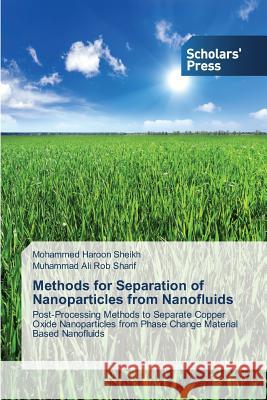Methods for Separation of Nanoparticles from Nanofluids » książka
Methods for Separation of Nanoparticles from Nanofluids
ISBN-13: 9783639706390 / Angielski / Miękka / 2015 / 124 str.
Phase change materials (PCM) are used in many energy storage applications. Energy is stored as latent heat of fusion through melting and is released during re-solidification. Dispersing highly-conductive nanoparticles (NPs) into the PCM enhances the effective thermal conductivity & energy storage capability of the PCM. This colloidal mixture with the NPs in suspension is called as nanoparticle enhanced phase change materials (NEPCM). A commonly used PCM for energy storage application is the family of paraffins (CnH2n+2). Mixing copper oxide (CuO) NPs in the paraffin produces highly efficient NEPCM for energy storage. However, after long term application cycles, efficiency of the NEPCM deteriorates and it needs replacement. Disposal of the used NECPM containing NPs is a matter of great concern & it cannot be discarded directly into the environment because of various short & long term health hazards for humans and all living beings. Due to rapid growth of NEPCM applications, post processing of used NEPCM needs immediate attention. This research work is a very first attempt of its kind to address this need by developing technologies to separate NPs using simple and economical methods.
Phase change materials (PCM) are used in many energy storage applications. Energy is stored as latent heat of fusion through melting and is released during re-solidification. Dispersing highly-conductive nanoparticles (NPs) into the PCM enhances the effective thermal conductivity & energy storage capability of the PCM. This colloidal mixture with the NPs in suspension is called as nanoparticle enhanced phase change materials (NEPCM). A commonly used PCM for energy storage application is the family of paraffins (CnH2n+2). Mixing copper oxide (CuO) NPs in the paraffin produces highly efficient NEPCM for energy storage. However, after long term application cycles, efficiency of the NEPCM deteriorates and it needs replacement. Disposal of the used NECPM containing NPs is a matter of great concern & it cannot be discarded directly into the environment because of various short & long term health hazards for humans and all living beings. Due to rapid growth of NEPCM applications, post processing of used NEPCM needs immediate attention. This research work is a very first attempt of its kind to address this need by developing technologies to separate NPs using simple and economical methods.











